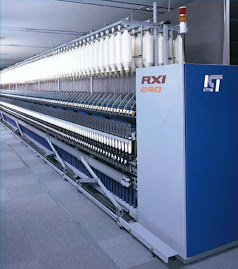Spinning is an ancient textile art in which plant, animal or synthetic fibers are twisted together to form yarn. For thousands of years, fiber was spun by hand using simple tools, the spindle and distaff. Only in the High Middle Ages did the spinning wheel increase the output of individual spinners, and mass-production only arose in the 18th century with the beginnings of the Industrial Revolution. Hand-spinning remains a popular handicraft.
There are mainly 3 types of spinning process:
- Melt spinning
- Dry spinning
- Wet spinning
Wet Spinning: Wet spinning is the oldest process. It is used for fiber-forming substances that have been dissolved in a solvent. The spinnerets are submerged in a chemical bath and as the filaments emerge they precipitate from solution and solidify. Because the solution is extruded directly into the precipitating liquid, this process for making fibers is called wet spinning. Acrylic, rayon, aramid, modacrylic and spandex can be produced by this process. In another way we also say that, Wet solvent spinning. Wet spinning also uses solvent to dissolve the polymer to prepare the spinning dope. The process begins by dissolving polymer chips in a suitable organic solvent, such as dimethylformamide (DMF), dimethylacetamide (DMAc), or acetone, as in dry spinning; or in a weak inorganic acid, such as zinc chloride or aqueous sodium thiocyanate. In wet spinning, the spinning solution is extruded through spinneret’s into a precipitation bath that contains a coagulant (or precipitant) such as aqueous DMAc or water. Precipitation or coagulation occurs by diffusion of the solvent out of the thread and by diffusion of the coagulant into the thread. Wet spun filaments also undergo one or more of the additional treatment processes described earlier, as depicted in Figure.

Figure: Wet spinning method
Air pollution emission points in the wet spinning organic solvent process are similar to those (Figure)Wet spinning. Wet spinning processes that use solutions of acids or salts to dissolve the polymer chips emit no solvent VOC, only unreacted monomer, and are, therefore, relatively clean from an air pollution standpoint. For those that require solvent, emissions occur as solvent evaporates from the spinning bath and from the fiber in post-spinning operations.
Application: Wet spinning is used for viscose, cellulose & some synthetic fibers, like poly acrylonitrile (PAN) from salt solution. This process is also used to produce Acrylic, rayon, aramid, modacrylic and spandex .
Below figure shows the step of this process-





Wet spinning is older system ,it is very suitable process cause low cost,spinning production very high lower tempt amd very good production quality of wet spiniing. so i am trying the wet spinning process continue of our all country. atlest this process step by step continue in our Bangladesh.
ReplyDeleteThe main purpose of a tensile testing machine is to determine the maximum stretching limit of any given material before it undergoes fracture. Wrap Reel
ReplyDelete